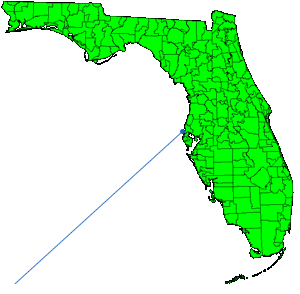 |
|
|
|
|
|
Tarpon Springs is a tale of two splendid cities molded into one community, visible by the active historic downtown and the equally historic Sponge Exchange district. Tarpon Springs incorporated as a city in 1887, was an early splash as a warm Gulf of Mexico waterfront resort community for northern aristocrats. A brochure "An Interesting History of Florida and the Famous Tarpon Springs," was published three years earlier to lure prospective land buyers. This led to the construction of the still visible, "Golden Crescent" of Victorian homes along Spring Bayou and by the turn of the century, Tarpon Springs was the largest city in Pinellas County.
|
|
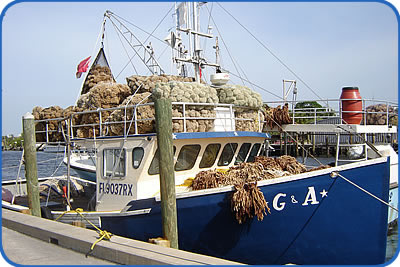 Anclote River Boat Loaded with Sponges |
In 1900, the destiny of Tarpon Springs turned to the water when the vast quantity of sponge beds just offshore was discovered. The rush was on to develop the world’s largest sponge market. Sponges at the time were collected using long poles with hooks in shallow water, known as hook method. A local Greek tried a new method of diving for sponges which proved to be much more efficient. Sponge diving continues today along with over a century of Greek Mediterranean heritage and culture. The waters surrounding the 50 Greek island group known as the Dodekanesos, with the island of Kalymnos at its center, had for generations been a major producer of the best sponges in the Mediterranean Sea. In the beginning of the 20th century the sponge diving industry had hard times in the Dodekanesos. The Sponge divers began looking for other locations to ply their trade. Tarpon Springs was a natural fit. |
One of the last remaining open and commercially active waterfronts in the Tampa Bay area, Tarpon Springs is a tourist attraction and also a true working port. One actually can witness sponges coming in and being readied for market to local and worldwide distribution. There are never enough sponges today to satisfy the market. But in its heyday, Tarpon Springs was the place to be until the market dwindled in 1946. Up until that time there were over 180 boats and 50 buyers ready at the local auction house known as the Sponge Exchange to buy and grade the sponges for the wholesale and retail markets. |
|
John Billiris was an early founder of the sponge industry in Tarpon Springs. In 1904, he brought his son Michael who was only 17 at the time, along with a few seasoned sponge divers from the Greek isles. Little did he know it would be the beginning of the Billiris sponge legacy in Tarpon Springs. At 79, George Billiris, owner of the St. Nicholas Boat Line and the son of Michael Billiris is an integral part of this legacy. George, who along with his wife Beverley, also the Tarpon Springs mayor, give visitors a chance to witness sponge diving off an authentic 50-foot Greek sponge diving boat that is tethered next to the Billiris Sponge Market. Many describe George as the heartbeat of the sponge industry in Tarpon Springs. In talking with him, it becomes apparent sponging is in his blood and he loves what he does. Along with his business and other interests, George also serves on the Tarpon Springs Tourism Council and frequently visits abroad to draw more interest in sponging and Tarpon Springs. |
|
| According to George it takes a special breed of man to be successful in sponge diving. “Sponging is pure, its natural and its known all over the world. The work is hard, challenging and tests one’s self-preservation, working 180 days each year, searching for sponges in 30 to 170 feet of water”. Mayor Beverley Billiris wants to preserve the identity of the community, but still change because “cities do need to change”. Beverley takes great pride in Tarpon Springs and speaks of ways to improve it, yet retain its rich history. For example, Tarpon Springs is currently working on a reverse osmosis plant as an alternative water supply to serve a growing community population. Although, the Sponge Exchange has been transformed from an auction block into a festival of unique shops, you can still buy each of the 4 types of sponges found locally, wool, yellow, finger and vase grass sponges. Today over 100 of the original Greek families remain, now in their third and fourth Tarpon Springs generations. You can still experience the Mediterranean flair with 25 Greek cuisine restaurants (such as Mykonos and Mama Marias) with spanakopita, dolmades, moussaka, souvlaki, gyros and of course, baklava for dessert. There are also 125 shops that include a 120,000 gallon salt water aquarium, a sponge museum, deep sea fishing excursions and everything Greek surrounding the Exchange along Dodecanese Boulevard and neighboring streets. The best part, according to George is that there are no chain stores in the exchange. The stores are owned and operated by local residents with less expensive goods that make for excellent shopper opportunities. |
|
 Historic Spring Bayou Home |
Tarpon Springs remains proud of its Greek economy along the Anclote River and in many places around the city tourists and locals can view a documentary on the sponge industry that was filmed in 1939. Tourism was a by-product of the sponge industry. Today, with over 1 million tourists each year, 47-recorded documentaries from 17 countries and 5 full-length movies, the Greek in Tarpon Springs will last for generations to come. Tarpon Springs is truly a mesh of two or more communities blended together. The community is extremely walkable, with something new around every corner. The historical 7-block downtown with turn-of-the-century streetlights filled with unique restaurants, antique shops, artisans, art galleries, a winery and other specialty stores would be the envy of most communities. In between the antique and art shops and delectable treats, one can stop in and create a work-of-art with the friendly and patient, mosaic artist, David Khalil at Mosaic Arts (118 Tarpon Avenue, # 4, 727.945.9310). Downtown in the Tarpon Springs Historical |
| Society Depot Museum (106 E. Tarpon Ave, 727.943.4624) with its collection of exhibits that interpret the history of Tarpon Springs. Also located in the historic downtown is the Tarpon Springs Cultural Center (101 S. Pinellas Ave, 727.942.5605) housed in the old Tarpon Springs City Hall building. It features the art and historical exhibits on the influence and impact of this historical community that can be quickly digested as you stroll and view the displays in the two galleries. |
|
Walking is recommended, stop by either the Tarpon Springs Chamber office across from St Nicholas Cathedral (11 E Orange Street, 727.937.6109) or the City Marina and Chamber of Commerce Visitors Center just before the Sponge Docks (100 Dodecanese Boulevard, 727.937.9165) for an easy to use walking map of Tarpon Springs. The staff at both chamber offices eagerly shares their knowledge of this wonderful community. T.J., the chamber president says, “there are so many years of family here. People chose to live here. It has a small hometown flavor”. If walking is not an option, ride the Tarpon Springs Trolley connecting the Sponge Docks with the historic downtown Arts and Antiques district. Additional connections to the Tarpon Springs Heritage Museum (100 Beekman Lane, 727.937.0686) in Craig Park, educates visitors on the interaction of environment and culture in this community that shares Victorian resorts, Greek commerce, and Florida style. While the trolley does not operate on Monday, the city-operated public trolley cycles by every 25-30 minutes and costs only $1 per ride or $3 for all day. Make certain exact change is at the ready. |
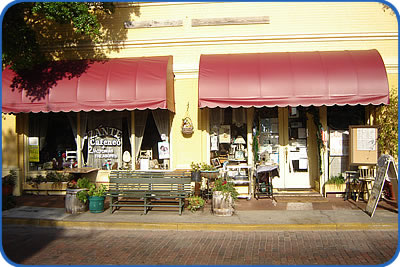 Historic Tarpon Springs Downtown Shop |
Craig Park, bordering Spring Bayou, one of six community bayous, is considered by many to be the centerpiece of the city, with many truly amazing border of historic homes. Craig Park is also home to the City’s War Memorial to veterans of all wars, especially Tarpon Springs residents who were lost during those conflicts. |
|
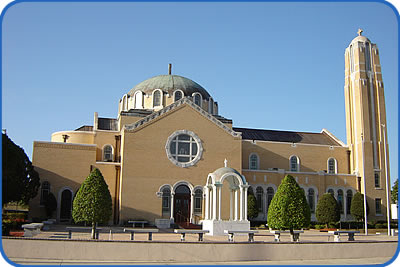 The St. Nicholas Greek Orthodox Cathedral |
With all Tarpon Springs has to offer, the most overpowering and humbling manmade site in the community, is the St. Nicholas Greek Orthodox Cathedral with its massive 60 tons of Greek marble. The original cathedral was chartered in 1908, cost $3,500 and seated 250 worshipers. Construction of the present Byzantine Revival building (36 N Pinellas Avenue, 727.937.3540) began in 1941 as a replica of St. Sophia of (Constantinople) Istanbul. The Cathedral was consecrated during the Epiphany festivities of 1943 and truly is one of the most spectacular Orthodox churches in the world. St. Nicholas is home to the largest Epiphany celebration in the United States. Each year on January 6th, local schools close, so students can join their families and over 25,000 others for this daylong Greek Orthodox event. The celebration begins with a morning service. This is followed by the release of a white dove of peace. Next is a mesmerizing ritual dive into the Spring Bayou by fifty local young men between ages 16 and 18 to retrieve a wooden cross. The young man who finds the cross is carried back to the church in a procession, where a short service is held to bless the diver. Greek-American male youths have braved the chilly January waters of Spring Bayou since 1920, in hopes of capturing the coveted Epiphany Cross. The rest of the day is set aside for Greek foods, music, and dancing. |
Whether walking or on the trolley try to visit the Unitarian Universalist Church (57 Read Street, 727.937.4682) home to the largest single collection of famous American landscape artist, George Inness, Jr. paintings. Both George Inness and George Inness Jr. were winter visitors in Tarpon Springs in the early 1900’s. The eleven large religious paintings were completed from 1897 through 1926. Less than one block away is the Safford House (Parkin Court, 727.937.1130) a lovely example of late 19th century Florida architecture complete with furnishings authentic to the period. |
|
| A few blocks to the north, just off Grand Boulevard is the intriguing St Michael’s Shrine (113 Hope Street). Just as in St. Nicholas Cathedral, you can light a candle 24 hours a day in this small sanctuary. A local Greek family erected it in the 1940’s as thanks for their son’s miraculous cure. St. Michael the Archangel is known as the great heavenly physician. Also not to be missed is the Leepa-Rattner Museum of Art (600 Klosterman Rd, 727.712.5762). Located on the 80-acre Tarpon Springs Campus of St. Petersburg College just west of US-19, the museum showcases 20th Century figurative expressionist Abraham Rattner’s works throughout his career along with numerous changing exhibits. |
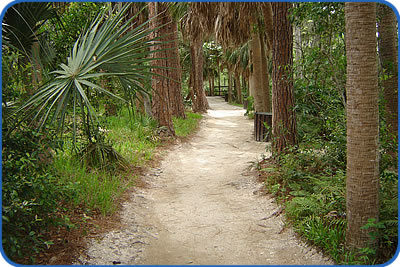 Hiking Trail on A L Anderson Park |
There is also plenty to do in the great outdoors while in Tarpon Springs. The community is home to two beachfront parks on the Gulf of Mexico. The Fred Howard Park (1700 Sunset Drive, 727.943.4081) is a 150-acre park with a 1-mile causeway and a thousand-foot public beach. Sunset Beach (west end of Gulf Road, 727.942.5610) is set up for picnics, swimming and boat launches. Not to be missed is the 128-acre A.L. Anderson Park (39699 US-19 N, 727.943.4085) located on Lake Tarpon with its lovely 478-foot nature trail, elevated boardwalk and abundant Florida wildlife. |
|
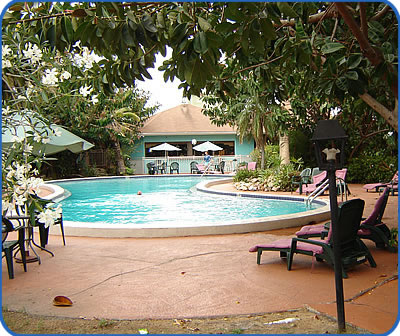 The Tahitian Resort in Nearby Holiday, Florida |
Bring your bicycles to Tarpon Springs. The 34-mile Fred E Marquis Pinellas (linear) Trail is built along an abandoned railroad right-of-way. It runs right from the heart of Tarpon Springs, thru Pinellas County and into St. Petersburg. This unique piece of protected green space is fantastic for walking, jogging, skating or biking. As a whole, Tarpon Springs is a unique community with a lot to offer. One day is definitely not enough to sample the various tastes and textures that is Tarpon Springs. |
|
Download a complete PDF version of the article on FloridaView Community Highlight prepared by www.FloridaView.com For a Community Highlight article on your community or business: advertising@floridaview.com or by phone at 386.698.4815 |
|
|
(Posting date 11 July 2006. Reprinted by Permission from www.FloridaView.com,Your Absolute Guide To Florida!) HCS encourages readers to view other articles and releases in our permanent, extensive archives at the URL http://www.helleniccomserve.com/contents.html. |
|
|
|
|
2000 © Hellenic Communication Service, L.L.C. All Rights Reserved.
http://www.HellenicComServe.com |
|
